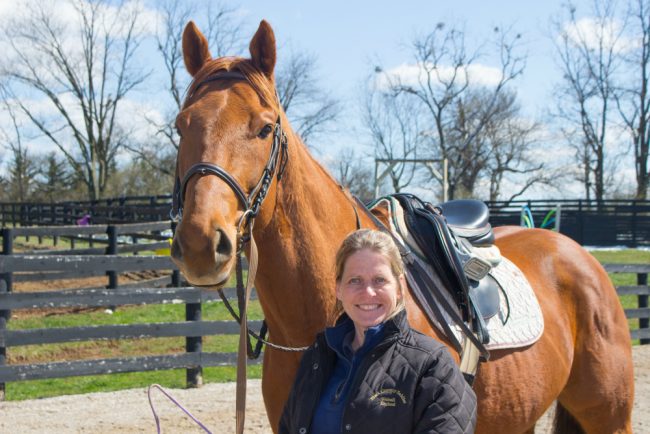Thoroughbred aftercare has changed drastically over the last decade. From the rise in popularity in off-track Thoroughbreds and those in the racing industry wanting to support their former charges, the aftercare landscape has shifted but the future is bright. One person who has experienced this first-hand is Susanna Thomas, executive director of the Maker’s Mark Secretariat Center, a Thoroughbred Aftercare Alliance-accredited organization.
TAA marketing and communications manager Erin Shea talked to Thomas about her experience at the MMSC and what she thinks is in store for the future of aftercare.
ES: How have you seen aftercare change since you’ve been at the MMSC?
ST: I came to the MMSC in October of 2007, three years to the month after it opened its doors at the Kentucky Horse Park. A week prior to my starting at the MMSC, slaughter—which had gone through all kinds of ups and downs in Congress for years—finally became illegal. At that time aftercare was really an afterthought at best. There were a few groups that had been around for a long time, the largest of them being the Thoroughbred Retirement Foundation, which was primarily a Thoroughbred sanctuary. The MMSC, which is an independent 501(c)(3) today, was originally part of the TRF and was created to promote Thoroughbred adoption.
The banning of slaughter in 2007 put a huge spotlight on the issue of aftercare. The racing industry, in response to calls for funding, started the voluntary (Thoroughbred Charities of America and The Jockey Club) check off in 2008. The view at that time, however, and maybe to some extent now, was that aftercare is a charity. I said then, and I say now, aftercare is not a charity issue. Aftercare is essential to the health and the longevity of this sport. But, at least in 2008, this was a start to the need for funding.
The next huge impact on the issue of aftercare was the global economic downturn of 2008. With the market crash and the country slumping into recession, you had people who had fewer disposable dollars to spend on horses. This, combined with slaughter, created an interesting dynamic that propelled recreational riders motivated by altruism and practicality (Thoroughbreds were less expensive than warmbloods) to look at OTTB adoption. The industry helped this movement with the creation of competitive programs such as the T.I.P. (Thoroughbred Incentive Program) Awards and the Take2 Award. Then Steuart Pittman comes along with his Retired Racehorse Project and Thoroughbred Makeover, and a true market is born.
So, you put those three things together—market changes, industry support, and successful visionary ideas—and you get a huge surge in interest and marketability for off-track Thoroughbreds. This combination has resulted in a proliferation of aftercare non-profits, which in turn, creates a need for the Thoroughbred Aftercare Alliance, to ensure accountability because anybody can just put out a non-profit shingle. At the same time, the success of the RRP and the Thoroughbred Makeover has resulted in a large number of people selling OTTBs for-profit. This makes it challenging for non-profits because the horses that are left behind are the ones that need the most funds and that are less marketable. This is a completely different climate than it was 10 years ago, and it presents new challenges.
But instead of being frightened by that, I think it is wonderful. It’s great for the breed; it’s great for the industry; it’s great for the MMSC. As an excellence junkie, I believe in striving to meet the challenges and do better.
ES: In your opinion, what is the biggest advancement in aftercare?
ST: There are two and I really couldn’t choose between them because they go hand-in-hand. One of them is the RRP, which does a lot of wonderful things in terms of its directory, seminars, and its website, and culminates in the Makeover, an event that single handedly has created the biggest explosion of our market. I’m not surprised, however. I’ve known Steuart Pittman for a long time and I said to him when I met him, ‘You’re going to change the game.’
The other biggest advancement is the creation of the TAA. The fact that the industry recognized the need for a standard of accountability and excellence is huge. It’s something that should be broadcast from the steeples—We care so much about what happens to our horses that we are going to make sure they are taken care of as they transition (off the track). That is powerful, and the success of the TAA in the blink of an eye has been phenomenal.
ES: What would you like to see for the future of aftercare?
ST: These animals run their hearts out and their legs off for us, yet when they can no longer race, they become disposable? Our racehorses are sentient creatures, and one would like to think we would embrace our consciences and recognize that horses need to be taken care of if not racing. Fully funding aftercare should be an obligation.
The other thing is education. I’d like to see more trainers and owners understanding that if you don’t run horses until they’re just rinds, they can have jobs. ‘Retire them before they break into pieces,’ is the message. It’s going to take education. When to stop (on a horse) and where to go are vital pieces of information that need to be shared.
It doesn’t take much to incentivize people. People chase money, yes, and money is hard to come by. But people also chase awards. Look at what the Makeover has done. What awards do people in the racing industry covet? The Eclipse Awards, for one. So why not give an Eclipse Award to the owner or trainer who has transitioned the most retired off-track Thoroughbreds to new careers?
The final piece is, if you want more horses to be retired sooner, you need to have many venues where they can be showcased. That includes local shows, unrecognized shows, recognized, all the way up to the National Horse Show.
Those are extremely achievable things. Especially with the momentum that’s currently happening. I am astounded by the changes in aftercare that I have seen in the last 10 years. I am excited by all the great changes ahead.
PHOTO: Erin Shea














